Physics 1
Determine the acceleration and the value of the normal force. Draw a free body diagram.
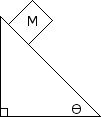
M = 10kg, = 30 degrees
Determine the acceleration of the system if M = 10 kg and m = 30 kg and = 30 degrees. Determine the tension in the rope as well.
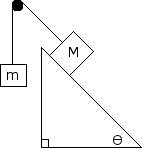
The large block M is 20 kg, and the smaller block, m, is 1 kg. The coefficient of kinetic friction is 0.2. Determine the acceleration of the system and the tension in the cords. The angle of the inclined plane is 60 degrees to the horizontal. Also draw a free body diagram for both blocks.

Determine the acceleration of the system if m = 5 kg and m = 10 kg and m. Determine the tensions T, T , and T .

A 3 kg box is pushed on a surface with a force of F = 15 N. The coefficient of static friction, is 0.3, and the coefficient of kinetic friction, is 0.1.
A. Does the box move?
B. If it does move, calculate the acceleration of the box.
A M = 8 kg box rests on a table and is connected to a second box of mass M = 4 kg via a rope that hangs over a pulley as shown. The coefficient of static friction, is 0.2, and the coefficient of kinetic friction is 0.1. Use a free body diagrams to answer the following.
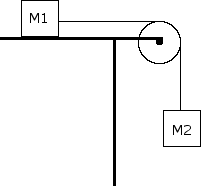
B. If the box does cause the system to move, what is the acceleration of the system, and the tension in the rope?
The large block m is 10 kg, and the smaller block m is 1 kg. The coefficient of kinetic friction is 0.1. Determine the acceleration of the system and the contact force between the blocks. The applied force, F is 30 N. Also draw a free body diagram for both blocks.

The large block m is 6 kg, and the smaller block m is 12 kg. The coefficient of kinetic friction is 0.2. Determine the acceleration of the system and the Tension T . The applied force, F is 36 N. Also draw a free body diagram for both blocks.

A ball of mass M is thrown vertically upward with an initial speed of v0. It experiences a force of air resistance given by F=−kv, where k is a positive constant. The positive direction for all vector quantities is upward. Express all algebraic answers in terms of M, k, v0, and fundamental constants.
Does the magnitude of the acceleration of the ball increase, decrease, or remain the same as the ball moves upward?
Write, but do NOT solve, a differential equation for the instantaneous speed vof the ball in terms of time tas the ball moves upward.
Determine the terminal speed of the ball as it moves downward.
Does it take longer for the ball to rise to its maximum height or to fall from its maximal height back to the height from which it was thrown? Justify your answer.
Sketch a graph of velocity versus time for the upward and downward parts of the ball’s flight, where is the time at which the ball returns to the height from which it was thrown.
A small block of mass MB= 0.50 kg is placed on a long slab of mass MS= 3.0 kg as shown below. Initially, the slab is at rest and the block has a speed v0of 4.0 m/s to the right. The coefficient of kinetic friction between the block and slab is 0.20, and there is no friction between the slab and the horizontal surface on which it moves.

A block of mass mis pulled along a rough horizontal surface by a constant applied force of magnitude F1that acts at an angle θto the horizontal, as indicated below. The acceleration of the block is a1. Express all algebraic answers in terms of m, F1, θ, a1, and fundamental constants.

A rubber ball of mass m is dropped from a cliff. As the ball falls, it is subject to air drag (a resistive force caused by the air). The drag force on the ball has a magnitude bv2, where bis a constant drag coefficient and v is the instantaneous speed of the ball. The drag coefficient bis directly proportional to the cross-sectional area of the ball and the density of the air and does not depend on the mass of the ball. As the ball falls, its speed approaches a constant value called the terminal speed.
Draw and label all the forces on the ball at some instant before it reaches terminal speed.
State whether the magnitude of the acceleration of the ball of mass m increases, decreases, or remains the same as the ball approaches terminal speed. Explain.
Write, but do NOT solve, a differential equation for the instantaneous speed vof the ball in terms of time t, the given quantities, and fundamental constants.
Determine the terminal speed vtin terms of the given quantities and fundamental constants.
Determine the energy dissipated by the drag force during the fall if the ball is released at height hand reaches its terminal speed before hitting the ground, in terms of the given quantities and fundamental constants. (this question requires knowledge of potential and kinetic energy, often not introduced until later in a physics course)
What is the tension T in the rope if the 10-N weight is moving upward with a constant velocity?
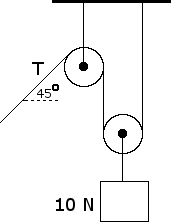
The 100 kg box shown below is being pulled along the x-axis by a student. The box slides across a rough surface, and its position varies with time according to the equation , where is in meters and is in seconds.

C. Calculate the net work done on the box in the interval = 0 to = 2 s would be greater than, less than, or equal to the answer in part (C). Justify your answer.
A nonlinear spring is compressed various distances x, and the force Frequired to compress it is measured for each distance. The data are shown in the table below.

In an experiment to determine the spring constant of an elastic cord of length 0.60 m, a student hangs the cord from a rod and then attaches a variety of weights to the cord. For each weight, the student allows the weight to hang in equilibrium and then measures the entire length of the cord. The data are recorded in the table below:

iii. Calculate the maximum speed of the object.
A rubber ball of mass is dropped from a cliff. As the ball falls, it is subject to air drag (a resistive force caused by the air). The drag force on the ball has a magnitude , where is a constant drag coefficient and is the instantaneous speed of the ball. The drag coefficient is directly proportional to the cross-sectional area of the ball and the density of the air and does not depend on the mass of the ball. As the ball falls, its speed approaches a constant value called the terminal speed.
A. Draw and label all the forces on the ball at some instant before it reaches terminal speed.
B. State whether the magnitude of the acceleration of the ball of mass increases, decreases, or remains the same as the ball approaches terminal speed. Explain.
C. Write, but do NOT solve, a differential equation for the instantaneous speed of the ball in terms of time , the given quantities, and fundamental constants.
D. Determine the terminal speed in terms of the given quantities and fundamental constants.
E. Determine the energy dissipated by the drag force during the fall if the ball is released at height and reaches its terminal speed before hitting the ground, in terms of the given quantities and fundamental constants.
A small sphere is moving at a constant speed in a vertical circle. Which of the following quantities is changing?
i. kinetic energy ii. potential energy iii. momentum
i and ii only
i and iii only
i and ii only
ii only
iii only
ii and iii only
In the system of two blocks and a spring shown below, blocks 1 and 2 are connected by a string that passes over a pulley. The initially unstretched spring connects block 1 to a ridged wall. Block 1 is released from rest, initially slides to the right, and is eventually brought to rest by the spring and the friction on the horizontal surface. Which of the following is true of the energy of the system during the process?
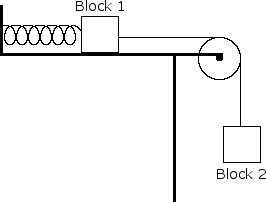
E. The potential energy lost by block 2 is greater in magnitude than the potential energy gained by the spring
In the situation above, after block 1 comes to rest, the force exerted on the rope must be equal in magnitude to
A. Zero
B. the frictional force on block 1
C. the vector sum of the force on block 1 due to the friction and tension in the spring
D. the sum of the weights of the two blocks
E. Shiang doesn't care, he just wants to sleep
F. the difference in the weights of the two blocks